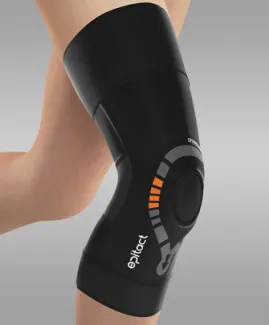
Patellofemoral pain syndrome (PFPS) is one of the most common knee conditions and concerns 25% to 40% of all knee problems in sports medicine(1). However, the signs and symptoms of patellofemoral pain syndrome are non-specific and can complicate the diagnosis. How to identify the knee symptoms of PFPS among all the conditions with similar symptoms?
Definition or PFPS
Patellofemoral pain syndrome is an umbrella term that corresponds to a painful syndrome affecting the knee joint. It often affects both legs.
It is a misalignment of the kneecap, which usually slips against the thigh bone (femur) in a groove called “femoral trochlea”. As a consequence, the kneecap doesn’t slip properly during knee movements.
Brief reminder of the anatomy and functioning of the knee
Before focusing on the signs and symptoms of patellofemoral pain syndrome, let’s understand how the knee works. The kneecap, or patella, stands at the front of the knee, in the centre of the femoral trochlea. This small bone acts as a pulley for the different parts (especially tendons) to allow leg extension. It has a very thick cartilage which can support high stresses, either from compression or sliding.
The proper pathway of the patella during knee flexion depends on the good balance of forces on each side of the joint. But, physical or biomechanical problems can affect this balance, so the kneecap doesn’t slip well in the joint. The more you flex your knee, the more the pressure increases on the patellofemoral joint. In PFPS, symptoms like pain often increase during knee flexion(2).
Main patellofemoral pain syndrome symptom
Painful symptoms in the knee are numerous and sometimes complicate the diagnosis. Discover what are the main signs and symptoms of patellofemoral pain syndrome.
Pain is the most common symptom of patellofemoral pain syndrome
Patellofemoral pain syndrome causes anterior knee pain: it appears at the front of the knee and is felt behind or around the kneecap.
This knee symptom of PFPS is said to be mechanical: it comes with movements, for example during the flexion or extension of the knee. Knee pain during flexion (e.g.: descending or climbing stairs or squatting) usually help to make the diagnosis of patellofemoral pain syndrome. In the same way, taking a slope down in the mountain, sitting or kneeling for a long time causes pain.
This condition often becomes chronic, with up to 91% of individuals reporting continued knee pain(4). By the way, it is possible that chronicity triggers psychological disorders like anxiety, depression, fear of motion (kinesiophobia) and their physical consequences.
Are there secondary knee symptoms of PFPS?
Because of the maltracking of the kneecap during movements, inflammation of some tissues within the joint can increase pain.
Joint instability is another sign or symptom of patellofemoral pain syndrome. It can be defined as an abnormal joint mobility of the kneecap in the trochlea. It gives the sensation that the knee is giving out, this is also called knee buckling. This instability increases stresses on the joint, which intensify patellofemoral pain.
Joint locking (the full extension of the knee is painful and impossible) is often and especially a symptom of patellofemoral diseases.
Joint cracking can also be a symptom of patellofemoral pain syndrome(7).
Do not confound the signs and symptoms of patellofemoral pain syndrome with those of other conditions!
In addition to being non-specific, the few knee symptoms of PFPS are similar to those of other knee diseases. This is why the diagnosis usually requires imaging examinations.
As a major symptom of patellofemoral pain syndrome, joint instability can be a sign of anterior cruciate ligament rupture. It is also common in patellar instabilities associated with repeated subluxations of the kneecap.
Joint cracking is also frequent when moving into a squatting position. This is often benign but it can be a sign or a symptom of patellofemoral pain syndrome, chondropathy or patellofemoral osteoarthritis, for example.
The anterior knee pain is not a specific knee symptom of PFPS(3). For example, a pain in front of the knee can be caused by a disease of the meniscus, quadriceps tendonitis or patellar tendonitis. Moreover, and especially in adolescents, the Osgood Schlatter disease and Sinding-Larsen-Johansson syndrome are both frequent diagnoses in case of anterior knee pain.
The knee is a complex joint that includes many structures: bones, tendons, ligaments, muscles… It is not surprising though that some symptoms are common to different conditions. The best way of clearly identifying your disease is to see a health professional and undergo a medical examination.
How to relieve the symptoms of patellofemoral pain syndrome?
To ease the painful knee symptoms of PFPS, you should first identify the movements and factors that are responsible for its onset. Try to limit sitting, squatting or kneeling for long periods of time and going down the stairs for example.
Note that overweight people more often develop patellofemoral pain as there is more pressure on the joints. So to protect your joints and prevent PFPS symptoms, weight management based on regular physical activity and healthy eating is also beneficial.
Moreover, physical therapy includes exercises such as stretching and muscle strengthening that can help with your pain and range of motion. Seek advice from a physical therapist. Those exercises focus on the leg (especially the hip, buttock and thigh muscles) to control pressure on the patellofemoral joint.
Rehabilitation also helps to correct the posture of the inferior limb and hip, which can lead to patellofemoral pain syndrome. If you have flat feet for example, orthopaedic insoles will improve the symptoms of patellofemoral pain syndrome.
Moreover, think about resting your joints, especially in the case of high physical activity levels (jumps, landing with knees bent under load, etc.)(5).
Finally, wearing a knee support relieves pain caused by patellofemoral pain syndrome. For example, the PHYSIOstrap® Sport* by EPITACT® is an innovative technology that enables you to continue or resume your sports activities. By stabilising your kneecap efficiently, it secures the knee during movements.
To limit the signs and symptoms of patellofemoral pain syndrome like chronic pain and loss of functional capacity, prevent the disease. Read the next articles about the frequency and diagnosis of patellofemoral pain syndrome.
*These solutions are class I medical devices that bear the CE marking under this regulation. Carefully read the instructions before use. Manufacturer: Millet Innovation. 08/2023
For more details about this general and simplified approach, here are further sources:
(1)Bump, Jared M., et Lindsay Lewis. « Patellofemoral Syndrome ». In StatPearls. Treasure Island (FL): StatPearls Publishing, 2021. http://www.ncbi.nlm.nih.gov/books/NBK557657/
(2)Jayaseelan DJ, Holshouser C, McMurray MW. Functional joint mobilizations for patellofemoral pain syndrome: a clinical suggestion. Int J Sports Phys Ther. août 2020;15(4):643‑9.
(3)Mostafaee N, Pashaei-Marandi M, Negahban H, Pirayeh N, Saki Malehi A, Ebrahimzadeh MH. Examining the diagnostic accuracy of common physical examination and functional tests in the diagnosis of patellofemoral pain syndrome among patients with anterior knee pain. Physiotherapy Theory and Practice. 19 déc 2022;0(0):1‑13.
(4)Noehren B, Scholz J, Davis I. The effect of real-time gait retraining on hip kinematics, pain and function in subjects with patellofemoral pain syndrome. British Journal of Sports Medicine. 1 juill 2011;45(9):691‑6. (5)Gaitonde DY, Ericksen A, Robbins RC. Patellofemoral Pain Syndrome. afp. 15 janv 2019;99(2):88‑94.
(5)Goux PL. Démembrement clinique et approche thérapeutique des syndromes rotuliens - Clinical analysis and treatment of the patellofemoral syndromes. Mise au point. 2005;(315):5. (7)Katarzyna Ustarbowska K, Bartosz Trybulec B. Physiotherapeutic management of a patient with patellofemoral pain syndrome – a case report. European Journal of Clinical and Experimental Medicine. 2018;(1):68‑75.
 Pharmacie
Pharmacie